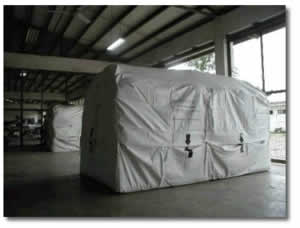|
|
Post production: Storage |
|
||||||||||
|
|
|
|
||||||||||
|
|
Hermetic Storage systems |
|
||||||||||
|
|
|
|
||||||||||
|
|
Describe hermetic storage and its advantages. |
|
||||||||||
|
|
What is the problem of storage in a tropical climate?
Rice grain absorbs moisture from the air around it. This means that if grain is in contact with the air (e.g. an open storage system) the moisture content (MC) of the grain will eventually become the same as the MC of the surrounding air. Open storage: The grain absorbs moisture from the air around it
In many tropical countries, there is often a high relative humidity and high temperature. High humidity and high temperature contribute to high moisture content. This means that in many tropical countries the moisture content is too high to safely store grain in an open storage.
This is why it is much better to store grain in closed storages, sealed off from the air. This is called hermetic storage.
As mentioned above, rice grain absorbs moisture until it reaches an equilibrium with the moisture in the surrounding air. The final grain moisture content you get in the storage is called the ‘equilibrium moisture content’ or EMC.
Click here if you would like to learn more about EMC.
|
|
||||||||||
Stop moisture and pests! Seal the rice hermetically! |
What are the advantages of hermetic storage?
Hermetic storage greatly improves grain quality and seed viability because of the following reasons:
|
|
||||||||||
Outside air and water can not touch the grain |
How do you store hermetically?Hermetically, or sealed, storage systems put grain in an airtight container such as a drum or a plastic bag that stop air and water getting in to the stored grain from outside.
The size of the hermetic storage systems can go from 3 kilograms to 300 tons. The hermetic storage system can be used for paddy, milled rice, seeds and other cereal crops such as corn and coffee.
Click here to learn the steps to store hermetically. |
|
||||||||||
Keep bags closed and free of air! |
A few things to keep in mind:
|
|
||||||||||
Next lesson |
Let's see what pests can damage the grain or seed during storage. |
|
||||||||||

![obj[1]](obj_1_.gif)




